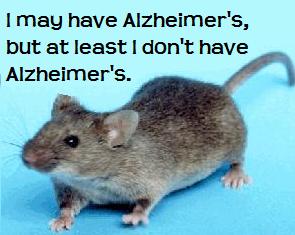
New research from MIT shows that sirtuins may be able to prevent or suppress Alzheimer’s Disease. Sirtuins are a class of proteins which may have life-extending effects and which many claim are activated by resveratrol, the substance found in the skin of grapes and associated with red wine. According to a paper recently published in the journal Cell, MIT scientists found that mice who produced excessive amounts of the SIRT1 sirtuin were less likely to develop brain plaques associated with Alzheimer’s. They also performed better in memory tests. Mice that produced no SIRT1 were more likely to develop plaques and performed worse in tests. While the research is very preliminary it may indicate a means of suppressing the development of Alzheimer’s and continues to fuel interest in resveratrol and sirtuin supplements.
As we’ve covered in previous discussions about resveratrol (here and here), the substance has become known for activating sirtuin production in the body. Several studies have shown that sirtuins, especially SIRT1, may be responsible for life-extending and body-preserving effects in animals. Now, it looks like sirtuins could play a key role in the prevention of Alzheimer’s and its symptoms. Alzheimer’s and other age related neuronal diseases like Parkinson’s and Huntington’s are an increasing concern as the world population continues to get older. Developing the means to treat such illnesses will be a large part of providing healthcare in the 21st century. If sirtuins can be used to produce positive effects in humans, then they may be the key to not only preventing neuro-degenerative diseases but to granting extended life and health to everyone.
The MIT research used several strains of genetically altered mice and one natural breed of mice as a control. One strain of mice (called AD) contain two human genes which produce excess A-beta peptides which lead to brain plaque and Alzheimer’s conditions. Another strain, (Tg), had a gene that produced large amounts of SIRT1 in the brain (typically double the normal amount). The BSKO strain had its SIRT1 gene knocked out, meaning it effectively produced no SIRT1 whatsoever. By crossing the Tg and BSKO mice with the AD mice scientists were able to get mice that were prone to develop Alzheimer’s but that had drastically different levels of SIRT1. Each strain of mice was monitored for health over several months and given various memory and fear-conditioning tests (all common to lab-mouse experiments). Brains were examined at different stages through autopsy to determine the plaque levels.
Scientists found that AD-Tg mice (the ones that produced high levels of SIRT1) showed little signs of Alzheimer’s and faired as well as normal mice in tests. AD mice clearly showed signs of Alzheimer’s and performed worse in tests. AD-BSKO mice (the ones with no SIRT1) actually died fairly early: 3-5 months compared to 11+ months. I should note, however, that the MIT researchers do not necessarily believe that it was the lack of SIRT1 that greatly shortened AD-BSKO lifespan – there may be more complex gene interactions responsible for the ‘inviability’ of the mice as they call it. When tested at 4 months the AD-BSKO mice performed significantly worse than natural or AD-Tg mice and had more brain plaque than the AD mice. Clearly SIRT1 was having some positive effect on the brains of the mice, and the lack of SIRT1 was very bad news.
As well as monitoring the effects of SIRT1 on Alzheimer’s like symptoms and plaque development, researchers were also interested in how SIRT1 was effecting the mice. They determined that SIRT1 was activating another protein, ADAM10, which was likely reponsible for reducing A-beta peptides and subsequent plaque formation. They also believe that ADAM10 activates the Notch pathway, a cell signaling system known for repairing neuronal damage. These discoveries about ADAM10 are a useful step in better understanding SIRT1 but also highlight how complex the effect of sirtuins can be in the body. There’s still much we need to learn.
Before you rush off to purchase resveratrol or sirtuin supplements for your aged aunt with Alzheimer’s, try to remember that this work is still very preliminary. While the mice involved did carry human genes that is no guarantee that excessive SIRT1 will have the same benefits when produced in humans. I should also point out that the mice who produced excess SIRT1 were doing so in their own cells, and in their own brains. They were not receiving this protein through supplements. As reported by the NY Times, most sirtuin supplements (and resveratrol) on the market are not able to cross the blood-brain boundary. You could take loads of sirtuins orally and never see SIRT1 levels rise in the brain. So while this work is very promising, and raises hopes that sirtuins could eventually be used as treatments for Alzheimer’s and other plaque based neural diseases, we aren’t there yet. The debate about the human consumption of sirtuin supplements and resveratrol is far from over.
[image credit: NIH via WikiCommons]
[source: NY Times, Donmez et al, Cell 2010]


